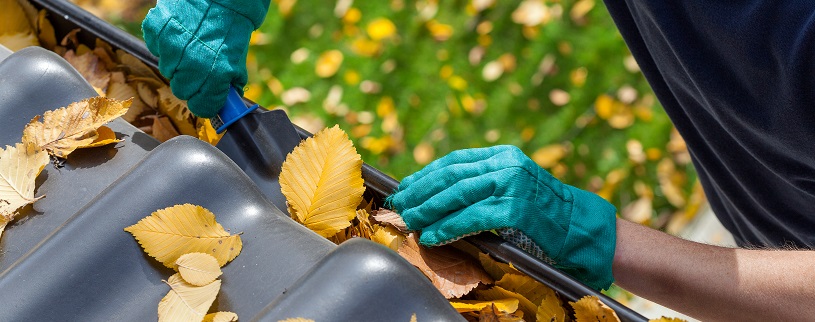The rainy season is upon us which is the perfect time to prepare your home for the next big storm to prevent water damage! Trust us, neglecting to prepare your humble abode can lead to a lot of costly headaches down the road. Here are 5 practical steps to make sure your home is ready for the rainy season.
1. Conduct a thorough roof check
The roof is the first line of defense against rainwater. If water manages to penetrate your roof due to any damage, it can seep into your home causing not only structural damage but also fostering an environment conducive to mold growth.
When inspecting your roof, there are several key elements to consider. Look for damaged shingles which may be cracked, curled, or blistered. These are signs of wear and tear, and damaged shingles can allow water to infiltrate the underlying roofing materials. Loose shingles are another concern. If they’re not properly secured, wind and rain can easily dislodge them, creating a path for water to enter your home.
Missing shingles are an even more direct invitation for water damage. If any shingles are missing, it exposes the underlayment and potentially the roof deck to the elements, which can lead to leaks and water damage inside your home. This can be identified by bare, exposed patches on your roof.
Bear in mind that while you can perform a preliminary inspection yourself, a professional roof inspection is recommended. Professionals are trained to identify and repair issues you might overlook. They can provide a comprehensive assessment of your roof’s health and recommend necessary repairs or replacements to ensure your roof is ready to withstand the challenges of the rainy season.
2. Clean gutters and downspouts
Gutters and downspouts are critical components of your home’s water drainage system. They guide rainwater from your roof and away from your home, protecting its structural integrity. However, they can often become a collecting place for various types of debris, such as leaves, twigs, and even nesting materials from birds or small animals.
Over time, this debris can build up and create blockages in the gutters and downspouts, impeding the proper flow of water. When water is unable to flow freely through these pathways, it can overflow, leading to a host of problems. This can cause water to pool around the foundation of your home, potentially leading to foundational damage, or it can back up and spill over the sides of the gutters, causing water damage to your home’s exterior walls or even seep into your home’s interior.
Regular maintenance of your gutters and downspouts is essential to prevent these issues. This includes removing accumulated debris, checking for and fixing any leaks or cracks, and ensuring that the gutters are securely attached to your home. In addition, downspouts should be checked to ensure that they are not blocked and that they are effectively directing water away from your home’s foundation.
Regularly cleaning your gutters and downspouts and ensuring they are in good working order can significantly reduce the risk of water damage to your home. However, it’s important to remember that cleaning gutters can be a dangerous task due to the height involved, so consider hiring a professional if you’re not comfortable doing it yourself. With proper care and attention, your gutters and downspouts can effectively protect your home during the rainy season.
3. Keep some buckets nearby
Despite even the most meticulous home maintenance, unforeseen situations like sudden roof leaks can occur, especially during heavy downpours. For such events, it’s wise to have a few sturdy buckets readily available. These buckets can serve as an immediate response to a leak by collecting excess rainwater, thus preventing it from spreading and causing further damage to your furniture, flooring, and other possessions.
While any bucket can serve this purpose, ensure the ones you select are sturdy and of sufficient size to handle a considerable amount of water. Buckets that are too small may fill up quickly and overflow if not monitored closely, while buckets that are too flimsy may not hold up under the weight of the collected water.
However, it’s crucial to remember that while buckets can provide a temporary solution to unexpected leaks, they don’t address the root of the problem. If you find yourself needing to use them, it’s important to arrange for a professional roof inspection and necessary repairs as soon as possible. A bucket can catch a drip, but it can’t fix a leak.
4. Elevate your valuables
In the event of potential flooding, one of your first steps should be to secure your valued possessions by moving them to a higher location. Flooding can cause irreversible damage to items of both monetary and sentimental value, so this preventive measure can save you from considerable loss and heartache.
If you live in a multi-story house, consider moving your prized possessions upstairs well in advance of any predicted heavy rainfall or flood warnings. This could include items such as electronics, important documents, family heirlooms, expensive furniture, and any other personal items that would be hard or impossible to replace.
For those living in a one-story home or apartment, similar precautions should be taken. Elevate your valuable items as much as possible by placing them on top of furniture, in high cabinets, or in the attic if accessible.
Do remember to ensure that these storage locations are safe and secure. Cabinets should be sturdy and well-fastened, and attics should be dry and free from leaks. Additionally, consider using waterproof containers or bags for added protection, especially for highly sensitive items like documents or electronics.
While it may seem like a lot of effort, taking the time to move your valuable items to a safer location can be a significant step in preventing water damage. It provides an extra layer of security for your possessions and can give you peace of mind as you weather the storm.
5. Be prepared for anything
Ensure you have essential emergency supplies like non-perishable food, bottled water, a first aid kit, and a reliable flashlight. Also, remember to secure important documents and any other emergency articles you might need. Don’t forget to make provisions for your pets as well!
With these preparations in place, you’re well on your way to weathering the rainy season safely. However, if something unexpected still happens (knock on wood), rest assured that we’ve got you covered. We offer round-the-clock service and can respond to your call within 45 minutes. Don’t hesitate to reach out to a 911 Restoration expert in your area!



